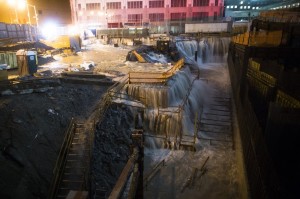Memorializing without change? Hurricane Sandy at the World Trade Center
12 November 2012 – Cathy Stanton

Michael Arad’s “Reflecting Absence” fountain in the footprint of the North Tower at Ground Zero, New York. Photo: Kai Brinker (http://www.flickr.com/photos/kbrinker/6156711439/in/photostream/)
Was I the only one who noticed this? There was an eerie similarity between Michael Arad’s “Reflecting Absence” memorial in the footprint of the Twin Towers and the virally-circulating AP photo of seawater rushing into the foundations of new skyscrapers at the World Trade Center construction site during Hurricane Sandy’s storm surge last week. “Something powerful about this image,” one tweet noted. “Zeitgeist moment.”
To my eye, the picture’s resonance came from the troubling layers of meaning and memory within the World Trade Center complex. The site reflects both the broadest extensions of American economic and technological power and the ways that that power has been spectacularly rebuked in recent years, both by those who have pushed back against the U.S.’s political and military presence in so many other parts of the world and–increasingly–by a planetary ecology saturated with the by-products of two hundred years of industrialism.
And yet we continue to build and rebuild, extending our reach outward and upward even as we’re also creating spectacular memorials to some of the most striking costs of our own power. Those parallel processes–commemorating without any real intention of changing direction–are what I see when I look at these two images together, and it makes me wonder, not for the first time, about how memorials can close off thought and memory as well as provoking them. Last week, it almost seemed to me that the hurricane itself was trying to underscore that point.
~ Cathy Stanton





1 comment